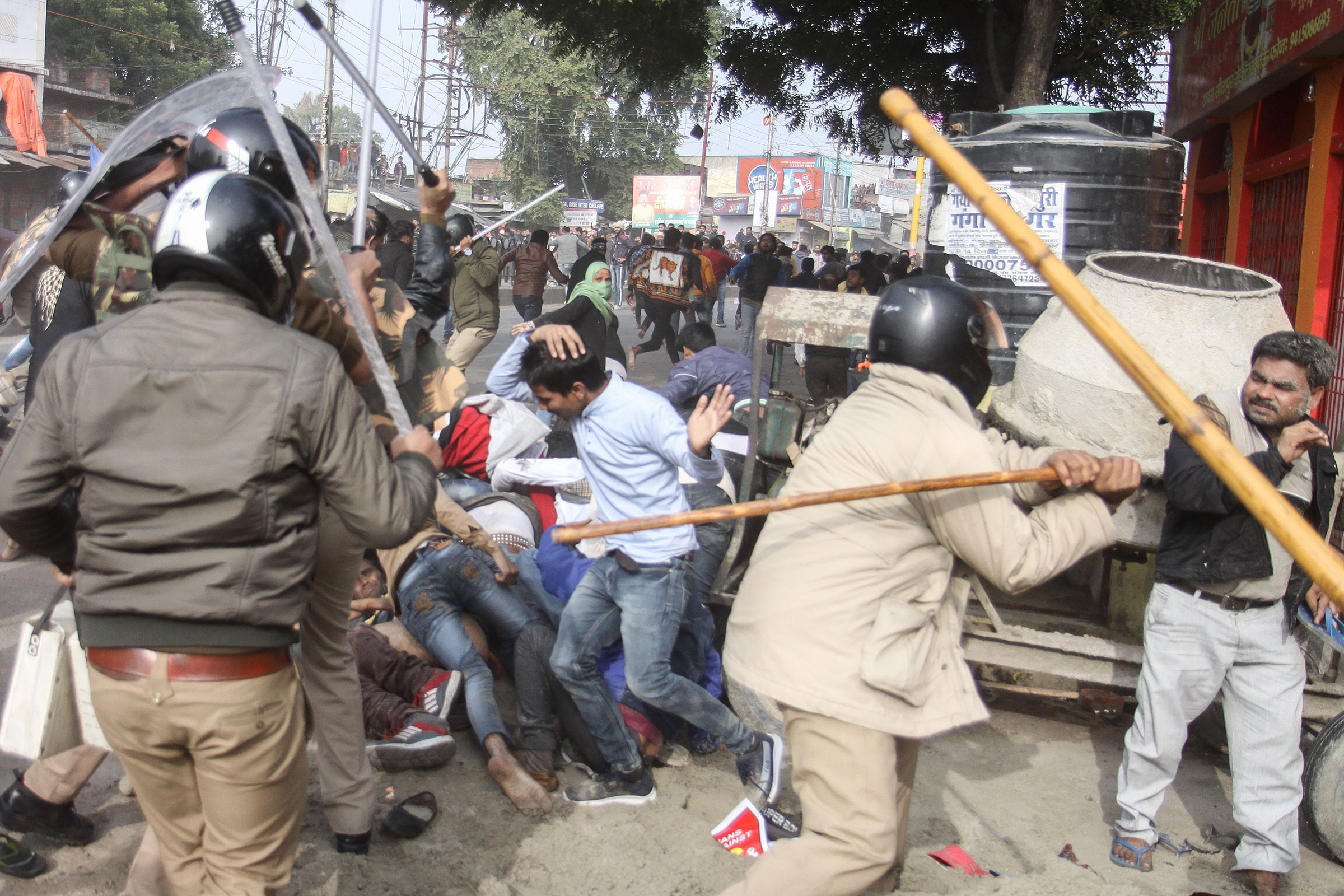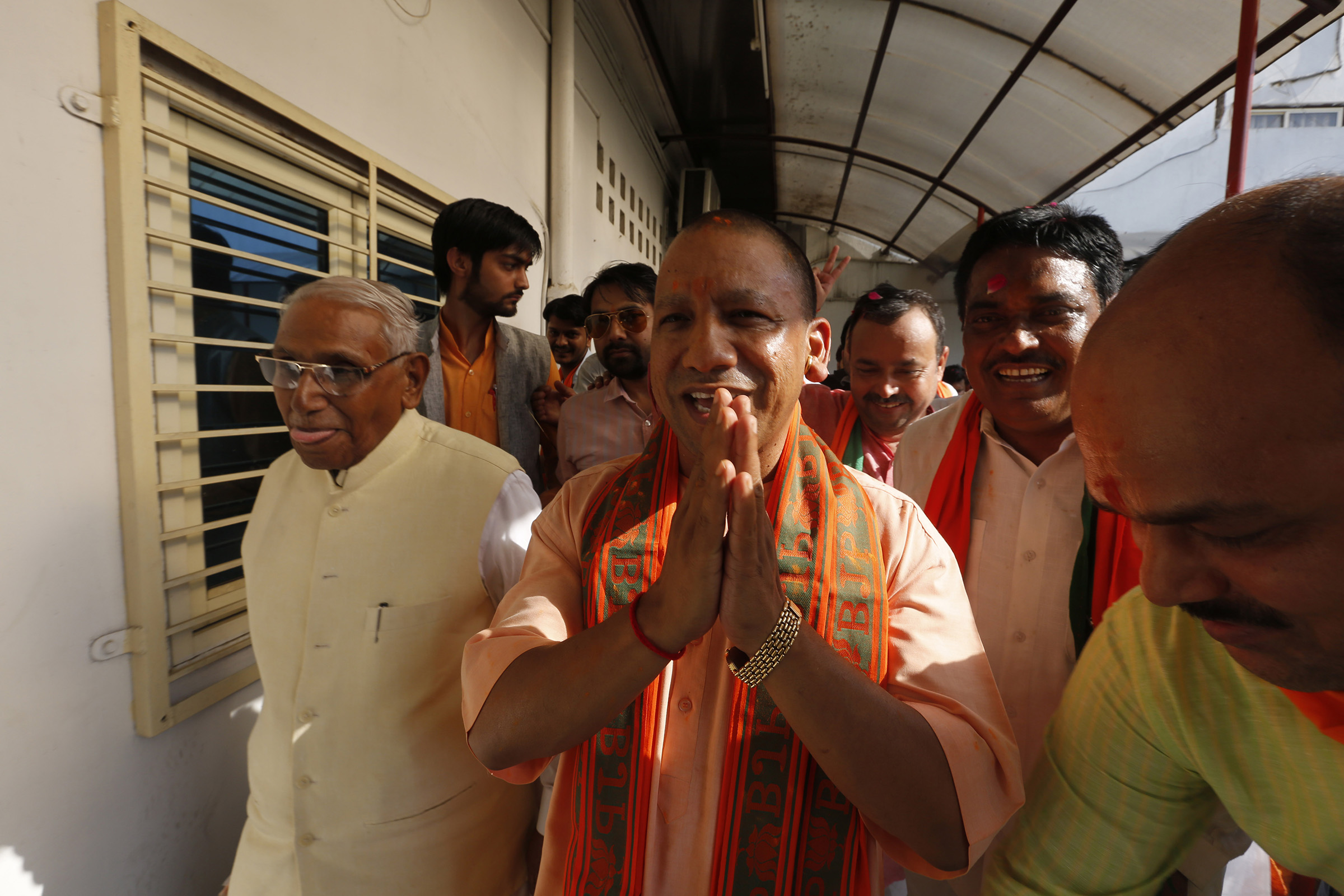
On Wednesday, cries of “kagaz nahin dikhayenge” (we wont show papers), “Tanasahi nahin chalegi” (we won’t allow dictatorship) rang out at the iconic India Gate in Delhi as protesters took a pledge to defend the constitution and continue to oppose Prime Minister Narendra Modi’s new citizenship law. Thousands of Indians brought in the New Year on Tuesday night with protests all over the country. Social media buzzed with protest notes and invitations to demonstrations at midnight. One note from the women of the Shaheen Bagh neighborhood in South Delhi — who have been holding a nonstop 17-day protest — invited people to join them for biryani, tea and protest songs and slogans to bring in the new year and “salute the fallen heroes in the struggle against this fascist regime, in Kashmir, in Assam, in Uttar Pradesh, in Karnataka, hit by police brutality in all corners of the country” and “to mark the first nationwide revolution for a new secular India.”
Anti-government protests had been brewing across India since almost 2 million people were stripped of their citizenship in the northeastern state of Assam earlier this year as part of the ruling Bharatiya Janata Party (BJP) government’s National Register of Citizens (NRC) exercise that makes it mandatory for all Indians to provide certain documents to prove citizenship.
That was followed by the Modi government’s move to implement the Citizenship Amendment Act (CAA), passing a bill on Dec. 11 that offers a fast track to Indian citizenship for non-Muslim refugees from the neighboring countries of Afghanistan, Pakistan and Bangladesh — specifically Hindus, Parsis, Sikhs, Buddhists, Jains and Christians who arrived in India before 2014. Protesters say that by granting citizenship to these communities but discriminating against Muslims, Modi’s Hindu nationalist government is undermining India’s secular constitution.
In response, tens of thousands of Indians have taken to the streets of Indian cities, in what marks the first serious opposition to the Modi administration since he took office in 2014. The protests grew after Dec. 15, when Delhi Police stormed into one of India’s oldest Muslim-majority universities — Jamia Millia Islamia — to curb student protests. A few hours later, police in Uttar Pradesh, India’s most populous state, cracked down on the Aligarh Muslim University, another Muslim majority university. After images of the crackdown on students at Jamia and Aligarh University started surfacing, the protests exploded. More than 1,100 people have been arrested so far and over 5,558 kept in preventive detention.
Together with the NRC, critics say the citizenship law is part of a broader plan by Modi’s party to expel Muslims. “We had to be here,” a young female student told TIME at an emergency protest in central Delhi on Dec 15. As police officers pushed against them with their riot gear, she stood holding hands with her peers in a human chain. “We are here in solidarity with the students and with everyone else in this country. We cannot be silent anymore.”
While much of India has been roiled by protests in the last three weeks, the violence has been particularly bad in Uttar Pradesh, where an estimated 19 people have died. The northern state is home to more than 200 million people, 19% of whom are Muslims. In cities across the state — from Lucknow to Meerut to Kanpur to Bijnor to Varanasi — there has been a constant stream of videos and reports of illegal detention, arrests on false charges, open firing on peaceful protesters, arson and looting by the police.
The state is ruled by Hindu monk Yogi Adityanath from the ruling Bharatiya Janata Party. Appointed the chief minister of Uttar Pradesh in 2017, the 47-year-old — in his saffron robe, shaved head, and crimson mark on his forehead — unapologetically represents the interests of a Hindu state. In 2002, he founded a Hindu youth militia, headquartered in his constituency. The group, which describes itself as “a fierce cultural and social organization dedicated to Hindutva and nationalism,” was charged by the police for inciting riots, arson and murder in Mau in eastern Uttar Pradesh in 2005.

The Mau riots were, according to an independent fact finding team at that time, the culmination of efforts by Adityanath over the last one-decade to organize Hindus against Muslims and polarize the state. “I am sending out a strong message,” Adityanath said in a speech given at an undisclosed location, recorded in Saffron War, a 2011 documentary by three Lucknow-based activists. “If one Hindu is killed, we will not use the administration to lodge an official complaint, we will rather use them to kill at least 100 such people who were responsible for killing him.”
On Dec. 27, a tweet from the Twitter account of Adityanath’s personal website and office said the Adityanath government’s strict crackdown had stunned protesters. “Every violent protester will cry now because there is a Yogi government in Uttar Pradesh.”
Indeed, it was a chilling New Year’s eve on Tuesday in Uttar Pradesh, with many protesters languishing in jail for taking part in a peaceful demonstration on Dec. 19 in Lucknow, UP’s state capital, that soon erupted into violence. One of them was social activist and Congress party spokesperson Sadaf Jafar. A livestream by Jafar had showed the police standing by as rioters wreaked havoc at the protest site. In the video, Jafar repeatedly requests the police to intervene and stop the rioting. “These are not protesters, they have come from outside,” she tells the police.
“There were women and children with us. We were peacefully protesting when suddenly miscreants took over and we were herded into shops and locked up while the police did nothing to stop the rioters,” Naheed Varma, Sadaf Jafar’s older sister, who was also present at the protest, told TIME.
Of the 39 people arrested on Dec. 19, all remain in detention. Jafar has been denied bail twice, despite the evidence in her videos that she was documenting the violence rather than inciting it. Varma couldn’t find her younger sister, for two days. When she was finally allowed to meet her, Jafar said a male officer had assaulted her. “They kicked her in the stomach and hit her with a baton. She was bleeding internally,” Varma told TIME. The UP police denied torture and said they have “enough proof” against her, Indian media reported.
Some hours after Jafar’s arrest, police also arrested Mohammed Shoaib, a 76-year-old human rights lawyer and founder of the Rihai Manch, a group that fights against police repression and illegal detention, and S.R. Darapuri, a Dalit rights activist. Both Darapuri and Shoaib had been put under house arrest on Dec. 18 and were arrested the next evening.
Jafar and 33 others were charged with 18 offences including attempt to murder, arson, criminal intimidation, intent to provoke breach of the peace, among others.
When theater actor and poet Deepak Kabir went to Hazratganj police station in Lucknow to find out about Jafar and others who had been arrested, he was assaulted by the police and then arrested himself. “You are asking too many questions, the police told him when he went to the police station,” Veena Rana, Kabir’s wife told TIME. “When I met him he looked battered.” She said her husband said he had been tortured.
Of the 39 people arrested in the Lucknow violence, 36 were Muslims, including prominent activists and dissident voices, although hundreds of Hindus also turned up for the protests, according to an open letter written by activist and Magsaysay winner Sandeep Pandey to UP Chief Minister Yogi Adityanath.
Incidents outside Lucknow have been equally troubling. In Muzaffarnagar, a 72-year-old timber trader had told the Kolkata-based Telegraph newspaper that policemen had vandalized his home, assaulted him with a rifle butt, looted jewelry and money and told him that Muslims had only two options; “Pakistan or Kabristan” (Pakistan or the graveyard).
An independent fact-finding team earlier this week confirmed these reports. The report had said Adityanath’s government was using unlawful and lethal tactics against protesters, especially Muslims and civil society activists not just to suppress dissent against the new law “but to send a signal to anyone who may dare to raise a voice against anything.”
It’s not the first time Adityanath’s administration has been accused of violence since he took office. In 2018, Human Rights Watch and the U.N., too, expressed concern over custodial violence and extrajudicial killings by the UP police. HRW said in a report that after the BJP formed the government in Uttar Pradesh in 2017, 63 people died in alleged extrajudicial killings by state police between March 2017 and August 2018. In January 2019, United Nations human rights experts sent detailed information to the Indian Government on 15 of the cases, 13 of whom were Muslims.
A sense of fear has pervaded the atmosphere in Uttar Pradesh. On Dec. 23, at the Civil Court in Lucknow, a group of parents were trying to blend in with the lawyers in their black and white clothes. Their children had been picked up by the police on Dec 19. The crowd included the father of a young mechanic, who was passing the protest site to deliver a scooter to a client. A day earlier, the parents were allegedly attacked on the court premises by right-wing lawyers, who rained kicks and punches on them, screaming, “These are the parents of anti-nationals. They are anti-nationals too. Beat them up.”
“How is it possible in any country for lawyers to resort to violence against parents of minors who had come to the court to secure their release?” A Lucknow-based human rights lawyer, who was in court on the day, told TIME. But in Uttar Pradesh today, such violence seems to have become the new normal.
More Must-Reads from TIME
- How Donald Trump Won
- The Best Inventions of 2024
- Why Sleep Is the Key to Living Longer
- Robert Zemeckis Just Wants to Move You
- How to Break 8 Toxic Communication Habits
- Nicola Coughlan Bet on Herself—And Won
- Why Vinegar Is So Good for You
- Meet TIME's Newest Class of Next Generation Leaders
Contact us at letters@time.com